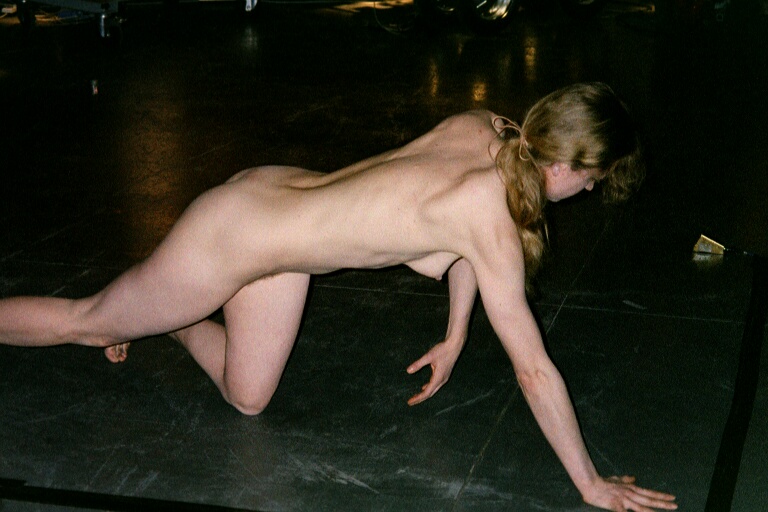
Godfried-Willem Raes
"Gestrobo"
a suite of studies for invisible instrument and robots
for an nude dancer, laptop performer and robot orchestra

This suite of compositions was started in 2002 and the number of sections and components increasing as we are building more robots for the M&M orchestra. All studies are designed to be completely interactive and receiving their inputs from a dancer. Musical voices can be assigned by the laptop player in real time. To this end the authors "Holosound" gesture control interface, based on sonar doppler detection, is used. For this reason, the performer has to be nude.
The automats that can be played are restricted to the following:
- <Troms>
- <Rotomoton>
- <ThunderWood>
- <Piperola>
- <Bourdonola>
- <Harma>
- <Player Piano>
- <Vox Humanola>
- <Klung>
- <Vibi>
- <Springers>
- <Dripper>
- <So>
- <Flex>
- <Tubi>
- <Belly>
- <Puff>
- <Trump>
- <Xy>
- <Bako>
- <Qt>
- <Krum>
- <Vacca>
- <Vitello>
- <Llor>
- <Psch>
- <Sire>
- <Simba>
- <Toypi>
- <Heli>
- <Bono>
- <Korn>
- <HarmO>
These robots constitute almost the entire robot orchestra built by the author up to the end of the year 2009. The setup on stage takes at least 120 square meters. The naked dancer should be placed central, surrounded by the automats.
Gestrobo forms in fact a collection of pieces that can be performed in a sequence, as a suite, as well as overlapping. Although the duration of the pieces is not limited in the software, it should be restricted to somewhere less then 30 minutes. The minimum duration should be 5 minutes. This will obviously become a function of the number of studies chosen for a performance and on the number of robots set up on stage for that occasion. The 'score' is completely embedded into the software.
Gestrobo consists of a large number of studies for individual robots, as well as some scored for orchestral combinations of these:
Vivoges, is a gestrobo study written for a naked dancer and a violin player (not the same performer). It was written for Moniek Darge and Emilie De Vlam.
Gestrobo Study #17: for a dancing viola player. Robots used here are: <Player Piano>, <Piperola>, <Bourdonola>, <Harma>, <Heli>, <Bono>, <Autosax>, <Toypi>, <Casta>, <Xy>, <Simba>, <Thunderwood>. This study was written for Dominica Eyckmans and premiered on 15 th october 2009. The score and/or choreography starts with the viola-player in the center of the triangle, the instrument held down. The <Puff> study starts the suite, then follow, spaced in time, <Casta>, <Psch>, <Toypi> and <Harma>. After harma, a code module specialy written for this composition follows (other mappings should be off): GeroFFT. This is a mapping wherein we map the body-surface differencials in the X,Y and X vectors after a spectral transform again with differenciation, on the player piano, harma and bourdonola/piperola. This translates the changes of the moving body in time into a sonic environment with a high input responsivity. The piece concludes with the mapping on Bourdonola.
Gestrobo Study #18: "Far stars fade with spectral shifts" was written for the M&M concert on december 17th 2009, where the theme was 'winter'. The scoring is for <Player Piano>, <Qt>, <Xy>, <Harma>, <Piperola>, <Bourdonola> and the newly build <harmO> robot. The performer dances and plays the viola at the same time. Technically this study samples the doppler sonar signals at about 1024 S/s on all three channels and performs 20 times a second a spectral transform on the incoming data in windows spanning 250ms. The results of these transforms are rescaled and remapped on the ambitus of the orchestra, whereby the varying remapping factors form the underlying compositional structure. The mapping of the 128 spectral bands derived from and unique to the gesture, undergoes a spectral shift downwards, equivalent to what we see in the analysis of the spectral data for stars fading away from the center of the galaxy in astronomy.
First try out: 15.08.2002 - Ghent, Logos Tetrahedron, M&M ensemble, with: Emilie De Vlam and the author. Further performances: Lille, Aeroneff, Maubeuge, Borderline Festival, Leuven, Hasselt...
You can watch some videoclips of sections of Gestrobo as performed by the author by clicking the links below (ca. 3MB per clip):
Gestrobo was also performed in Leuven on march 17th of 2005, by Nicoletta Branchini and the author. Here are some pictures:
..
..
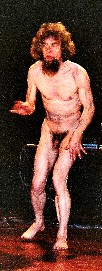
At the occasion of the 40th aniversary of Logos, a special compilation was composed by the author under the titel 'Flash'. It was premiered on december 6th 2008 by the author.
On october 2009, a new Gestroby study (#17) was premiered for a dancing viola player, performed by Dominica Eyckmans
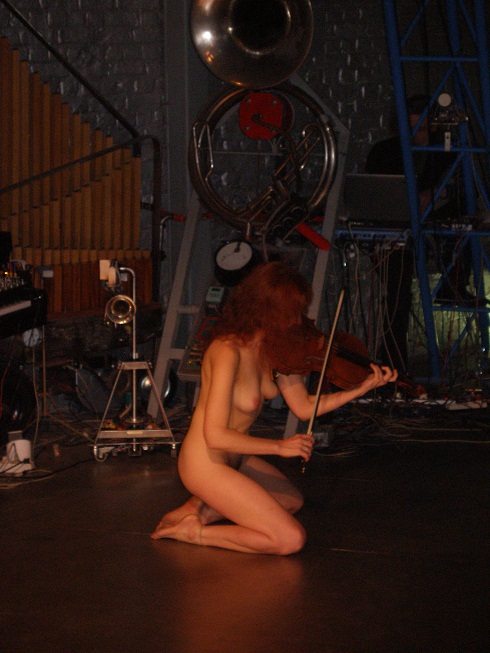
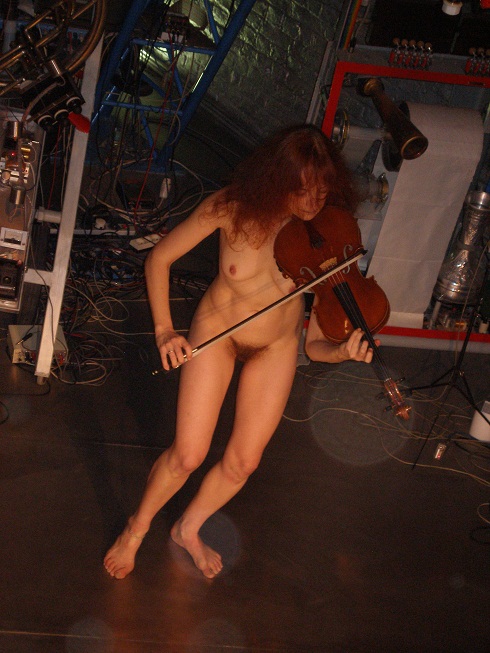
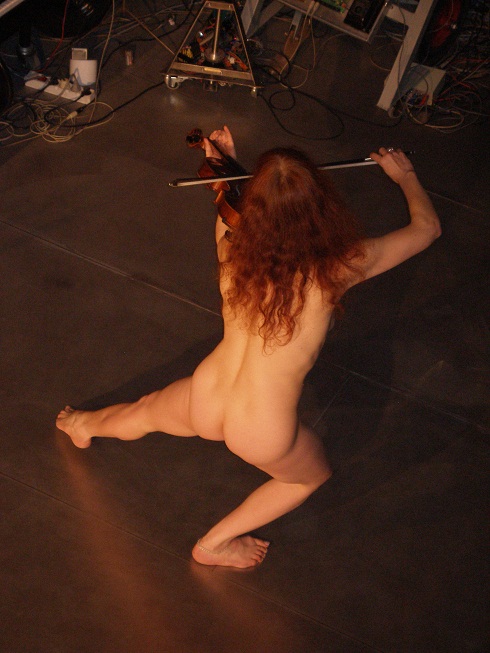
Gestrobo Study #18 is also known under the name "Far stars fade with spectral shifts" and makes use of the newly developped doppler data acquisition on the same hardware platform, but with much higher sampling rates and very intensive real time spectral transforms such that holistic mapping of gestural shaped on highly polyphonic sound material becomes possible. The orchestration makes use of a large selection of robots in the M&M orchestra, including the newly build <harmO> robot. This study was written nov/dec 2009 and premiered on december 17th 2009 by Dominica Eyckmans and the author.
Gestrobo Study #19 ('Ices') uses again the original version of the invisible instrument and is orchestrated for Bourdonola, Puff, Xi, Simba, Thunderwood, HarmO and Qt. It was premiered by Dominica Eyckmans and the author on january 13th 2010. These are some pictures of that performance:
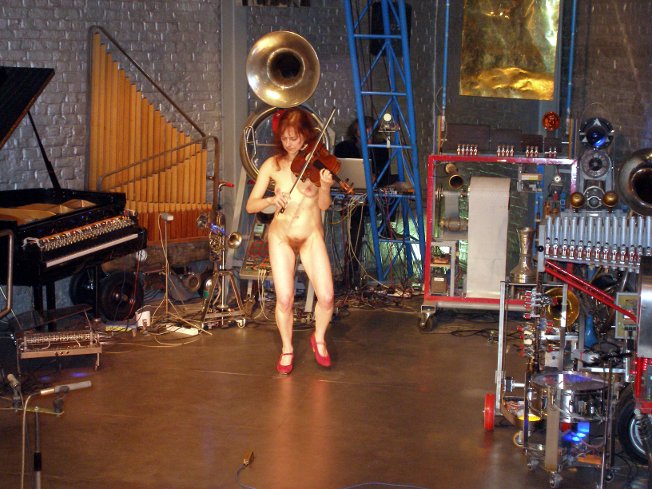
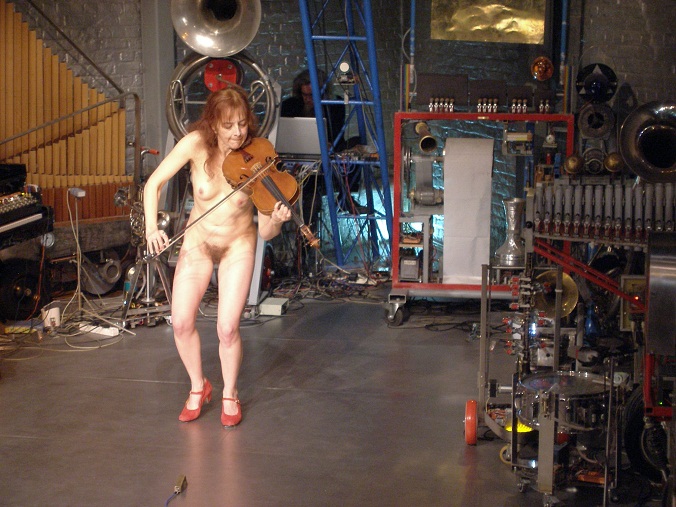
Gestrobo Study #20 ('Bodies of Revolution') makes use of the new developped doppler data acquisition on the same hardware platform, but with much higher sampling rates and very intensive real time gesture analysis software. The orchestration makes use of a very limited selection of robots in the M&M orchestra: <Ob>, <Korn>, <Heli>, <Bourdonola>, <Autosax>, <So> and <Player Piano> as well a the live viola sound. This study was written jan/feb 2010 and premiered on february16th 2010 by Dominica Eyckmans and the author. These are some pictures of that performance:
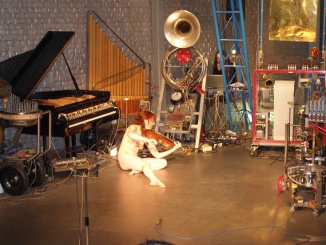
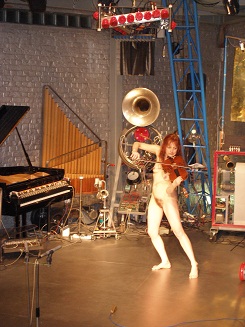
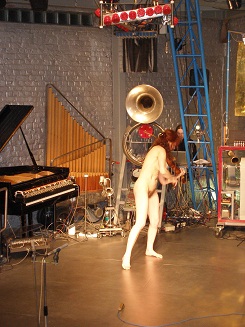
The first part of this composition makes extensive use of the microtonal possibilities of the monophonic instruments in the robot orchestra and all inflections -fully gesture controlled- are restricted to a semitone. It has a very important live viola part. The second part requires bodyrevolutions and rotations to steer the up- and -downgoing melody lines of the robots. The ending uses some sounds from our <Thunderwood> as well as the <Psch> robot. The duration of 'Bodies of Revolution' is 7' to 8'30". In more than one respect, this piece forms a bridge to the later series of Namuda studies, such that it could also be considered to be Namuda Study #0.
| P.S.: Voor uitvoeringen van dit stuk moeten noch mogen auteursrechten worden betaald. Elke poging tot inning van auteursrechten, door welke instantie ook, naar aanleiding van publieke uitvoeringen van dit stuk kan gerechterlijk als poging tot afpersing worden vervolgd. |